Sarah Tucker
14 July 1827 – 15 February 1917
To listen to people on the streets of Salt Lake City during the 1850s
and 1860s, one might think he was in London with so many people
speaking with delightful English accents. Of the pioneers that
crossed the plains, the trail heads on the Missouri River was not the
beginning of their journey. For so many, the trek across the plains
began after a seven or eight week ocean voyage on a sailing ship.
Followed by a ten or twelve day trip up the Mississippi River on a
steamboat. Their stories are much like that of Sarah Tucker Gover.
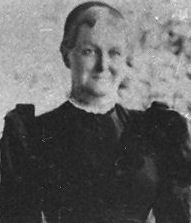
Sarah Tucker was born July 14, 1827 in Clutton, Somersetshire, England. She was the eldest daughter of William Tucker and Martha Rogers. She was the second of eight children, but her older brother died as an infant. Therefore, Sarah was the oldest of her brothers and sisters. Her siblings were: William (24 July 1826 – 2 August 1826), Emma (7 May 1830), John (26 November 1832), William (24 May 1836), Joseph (22 August 1839), Martha Ellen (11 April 1843), and Emily (3 January 1849).
As Sarah grew up and left home, she worked as a nursemaid, living in the homes of her employers. In one home where she was employed, there were two cooks, two housekeepers, and two nursemaids. The parents were very particular about their children's diet; each child was fed according to its age. The mother only came into the nursery long enough to nurse the youngest. Sarah was naturally left handed, but was not allowed to use her left hand in front of the children. As a result of this she became adept with both hands; even years later in sewing and quilting, she was an expert at using both hands equally as well.
Sarah married Maurice Gover in the Clutton Parish on June 11, 1848. Maurice, who was born on November 6, 1827, was the son of Charles and Ann Day Gover of Clutton.
They left Clutton and moved to Abersychan, Monmouthshire, South Wales sometime between their marriage in June of 1848 and June 1849 as the mines in Somerset were worked out. Sarah's family also moved to Abersychan about the same time. It was there that Sarah's first child, Emily, was born on June 18, 1849.
They were happy and comfortable as he did well financially. They had a nice home and were quite contented when the gospel message was brought to them by Elder Cooke. Morris was interested and began investigating immediately.
Sarah was not so readily impressed. She said they were happy and contented, and she was very satisfied before the Elders made such an impression upon her husband. She felt confused about the Mormons. Nevertheless they joined The Church of Jesus Christ of Latter-day Saints. Morris was baptized April 10, 1849. Sarah was baptized on September 10, 1849 by Maurice.
After they joined the church, it was hard to secure work. Most of the
employers were so antagonistic towards the Mormons. They lived in
Wales where he found employment until he could save enough to come to
America. Both of their parents were opposed to them going to America.
Sarah's mother, Martha Rogers Tucker told Sarah to tell him she
didn't want to go. If she would be determined not to go to America,
then Maurice would not go without her. When she asked him about it he
said, "It is my desire to take you with me, but if you will not
go then I shall go alone." Sarah said, "I knew he meant
it."
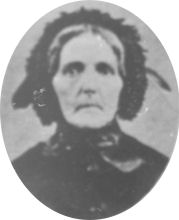
Sarah's mother:
Martha Rogers Tucker
Just before leaving for America, their son, Elijah was born January 22, 1853 in Abersychan. Elijah was one month old when they boarded the International. While waiting for the wind to take them out to sea, he died the night before the ship was to sail. Maurice got permission to leave the ship and took the little child's body to some farmers he found in a field in Kea Cot, England, and gave them some money to bury the baby. They always felt comforted that he was buried on land, instead of at sea. Saddened, Maurice, Sarah, and four year old Emily pressed on.
The International left Liverpool on February 26, 1853. On board were four hundred twenty five Saints under the presidency of Elder Christopher Arthur and his counselors, John Lyon and Richard Waddington. Captain David Brown of Provincetown, Massachusetts, was part owner and master of the vessel. During the crossing there were seven deaths, seven births, and five marriages. Elijah's death was recorded in the captains log before setting sail.
Shortly after the ship left port, Elder Arthur called a meeting of priesthood holders in the company. He then divided the emigrants into eight wards, six for the steerage and two for the second-class cabin passengers. An elder presided over each ward and was accountable to a general council. These leaders were responsible for the health, behavior, and welfare of the emigrants. Every evening, meetings were held for worship, instruction, and testimony bearing.
The emigrants drew their rations, consisting of hardtack, rice, tea,
sugar, salt, beef or pork once a week. They were given four quarts of
water each day and had to get it early in the morning. As soon as
they were organized they commenced a routine, which was up at
daylight and get breakfast. Then came morning prayers in all the
wards, then it was sweep and clean up. After that they could
promenade on deck, sing or do whatever they chose until time to get
dinner. The cooking was done by two young men in a little house on
deck called the galley. In the morning they would have two big
boilers of hot water and those who wished tea, would take some of
their cold water and exchange it for some hot water. The meat was all
boiled together, each person tying a wooden or tin tag with his name
or berth number to his piece. Rice was tied in a bag and cooked the
same way. If a person wanted anything fried or cooked in any other
way, they would have to wait their turn. Most of the passengers took
fresh meat, fresh bread, butter and many other things with them, so
that we didn't suffer for anything to eat.
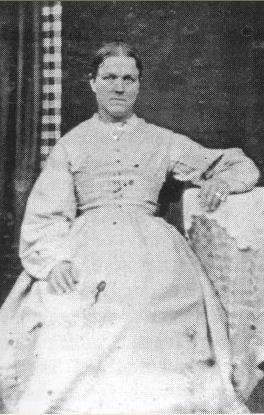
Sarah Tucker Gover
For five weeks the ship encountered head winds and some heavy gales that slowed their progress. In one storm the vessel nearly capsized. After five weeks at sea, the Captain declared that if he were to turn the ship around they could be back in Liverpool in just ten days. Elder Arthur called a meeting and explained the situation and the Saints fasted and prayed for a fair wind the following day. That afternoon at four o'clock the wind changed.
On the 6th of April the emigrants assembled on the forecastle to celebrate the twenty-third anniversary of the organization of the Church. Six musket rounds were fired and the festivities began. The celebrants marched to the poop deck, and the leaders robed in sashes with white rosettes on their chests took their seats with their backs to the mainmast. Twelve young men and twelve young women, picturesquely robed, seated themselves on each side of the presidency. Then there were scripture readings, partaking of the sacrament, speeches, singing, recitations, dancing, and four marriages. The program lasted until late at night. President Arthur wrote: "everything was done with the highest decorum."
This happy voyage ended at New Orleans on the 23rd of April – a
fifty-four-day passage. The captain said that he had never sailed the
same distance covered during the last three weeks of the voyage so
fast, at times sailing about two hundred twenty miles a day. Except
for minor bouts of seasickness, the emigrants were remarkably free
from illness.
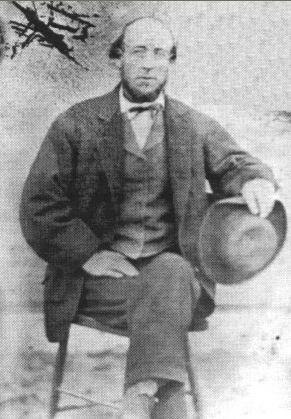
Maurice Gover
This After landing in New Orleans, they sailed up the Mississippi River on a steamboat for a thousand miles to Keokuk, Iowa. From there, they crossed the plains to Salt Lake City with one of the church teams, the Jacob Gates' company. This company was part of the Perpetual Immigration Fund that was provided for those coming across the plains that did not have any other means. Those who came this way reimbursed the church later. The company they came in consisted of two hundred sixty-two people, thirty-three wagons, one hundred forty-seven oxen, forty-seven cows, two mares, one bull, three lambs, and five dogs.
While crossing the plains it was necessary to go through many streams and many rivers. The men would tie ropes around their waists and swim to help pull the wagons. After one of these exhausting experiences, Maurice came down with a severe cold and had what was then called ague fever. As a result, he had to ride the rest of the way. His illness left Sarah to care for Emily, gather firewood, and do all of the work in camp that each family was expected to do. She walked the entire journey across the plains. Maurice never completely recovered from this illness.
The Indians were very troublesome riding up close to the travelers, doing anything they could to annoy them and attempted to capture some of the women. Sarah was very frightened by the Indians so she, with her little daughter Emily, walked along together by an older lady who was not afraid of the Indians. The older woman would strike the Indian's horses with her stick to drive them away when they came too close. Sarah would rather give things to the Indians to keep them from bothering them.
When the company started out, the food supplies were stored together, but when they were getting low the food was divided out among the families. They arrived in Salt Lake City on September 30, 1853. Maurice and Sarah had one quart of flour left. They slept in a wagon box the first night and the next day Sarah began working at a home where her pay was their board. She had a beautiful piece of wide bright colored ribbon that she traded for some ground com. She sifted the corn through a piece of thin cloth and was about to throw the hulls away, but thought she had better save them. Later, she was glad to mix them with water and bake it . They had other nice pieces of clothing, which they traded for food; some clothing items were very hard to part with.
One Sunday they were walking to church and hadn't eaten for some time. Their little daughter Emily began to cry because she was so hungry. It hurt Sarah's pride to beg, but she took her daughter to the home of Sister John Taylor and asked for a piece of bread. Sister Taylor insisted they all come in, and she would give them the best she had, which was bread and beet molasses. At this time they lived in the Tenth Ward and later moved to the 19th ward.
Maurice was a trained stone cutter and worked in the rock quarry in Big
Cottonwood Canyon for sixteen years carving out the granite blocks
for the Salt Lake Temple. He would leave on Monday morning and not
return until Saturday night. For wages, he received some money and
the rest in food and supplies for the family. Sarah would go to the
tithing office and stand in line, sometimes all day for her turn to
get supplies.
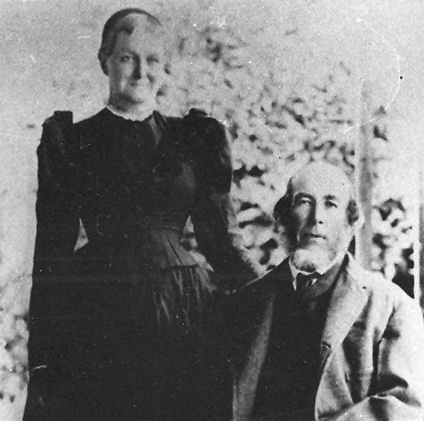
Sarah Tucker and Morris Gover
Maurice and Sarah's marriage was solemnized in the Endowment House in Salt Lake City, Utah on September 25, 1855 by Brigham Young and witnessed by Heber C. Kimball and Jedediah M. Grant. Maurice' and Sarah's marriage record from Clutton Parish, the emigration records, and the early church records of the Salt Lake and Clarkston wards, as well as the citizenship records, all give his name as Maurice. At some point he changed his name to Morris sometime after moving to Utah.
While living in Salt Lake City, six more children were born. Lydia (November 24, 1854), Henry Morris (December 20, 1857), Martha Ann (March 24, 1860), Sarah, who went by Sadie (February 8, 1862), Emma (November 19, 1864), and Rosena (June 3, 1868). Emily, married George Godfrey on November 26, 1865 and established a home of her own. She was not yet seventeen when they were married.
The children helped their mother gather sagebrush on the hill north of the city for fuel. The hill is probably in the vicinity of where the State capitol building is now located. They made the trip once a week to get extra fuel for washday. They saved the wood ashes in a barrel. They put water on the ashes to extract the lye. The lye was used to soften the water for laundering and to make soap. All the soap used by the family was made at home with meat scraps and lye.
The family moved to Newton, Cache County, Utah in about 1869. They lived
there a short time and then moved to Clarkston. There, they bought a
farm with a one-room log house and a wagon with a team of horses for
their son's employment since Morris. had no interest in farming. The
log house did not have a ceiling in it, only the rafters and a dirt
roof. When it rained, it was necessary to set pans and buckets on the
beds to catch the rain that leaked in. They used clay to whitewash
the walls to make them white and clean. Sarah was very particular
about her home and her personal appearance. She worked hard to make
sure it was always neat and clean.

The Gover home in Clarkston.
This frame house was built later on the same parcel as the log house.
The home was located on the southwest comer of the city lot, North block; number three. There was a spring nearby and they carried water for all of their needs. Their beds were made of four blocks of wood, cut from a large log for the legs and a wooden frame built on top of them. Ropes were laced back and forth for springs. For the mattress, a tick was made of cloth and filled with straw, or cattails that had been burst open. The tick was washed and refilled with clean straw often.
Candles made by Sarah and her daughters lighted their home. The candles were made of melted mutton tallow, and set to harden in candle molds. After the family moved to Clarkston they had a kerosene lamp. This lamp had to be filled, its chimney washed, and the wick trimmed every day. It was a great improvement over the candles. From then on, much of their sewing and reading was done by lamplight. Before long, Morris had a new home built on the same parcel as the one room log cabin.
Mule drawn freight wagons used to pass through Clarkston on their way
north into Idaho and Montana. These freight wagons brought tragedy to
the Gover family. Their son, Henry, and some of his friends were
sampling the freighters beer by putting hollow wheat straws into the
kegs. Henry got some of the foam from the top of the keg. Cobalt,
which is a heavy metal, used to be added to beer to stabilize the
foam, but it could be poisonousness under certain conditions before
the foam evaporated. This caused his death on May 25, 1875 at the
age of eighteen. After Henry died, Morris sold the farm.
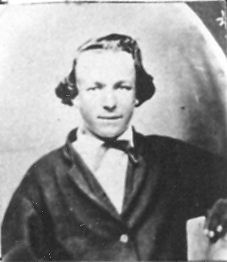
Henry Morris Gover
That was not a good year for the Gover family. They family came down with diphtheria and Sadie, who was fourteen, died from the disease on September 21, 1875.
Over the years, Sarah remained in touch with her family in England and
received several letters from them, especially her mother. In 1894,
Sarah received some money from the estate of her brother William, who
lived in England. He did not have any children. The amount of money
was about $150.00.

The Gover Women. Standing: Rosena, Emma, and
Martha. Seated: Sarah Tucker Gover, and Lydia
Sarah was always active in the church and served as a Relief Society teacher for many years.
Sarah had a feather bed and she liked it made just exactly so. If it wasn't made to her liking, she'd take it apart and remake it until she got it as she wanted it. No one else could please her, until they finally learned to do things her way. When she was older and her health wasn't very good. She was more willing to let people help her She liked having t he company as much as she did the help that they were to her.
Morris Gover died in Clarkston, Cache, Utah, on June 7, 1908; he was eighty years old. Sarah Tucker Gover died in Clarkston, February 15, 1917 at the home of her daughter Emma Gover Buttars. She was eighty-nine years old. She was the oldest of her family and lived the longest life. And she was the only one to immigrate to America. Maurice and Sarah are buried in the Clarkston cemetery. They had forty six grandchildren, seven of which died as babies or small children.
The main source for this biography was the “Life Story of Maurice Gover and Sarah Tucker” written by Archulious B. Archibald and other family histories.